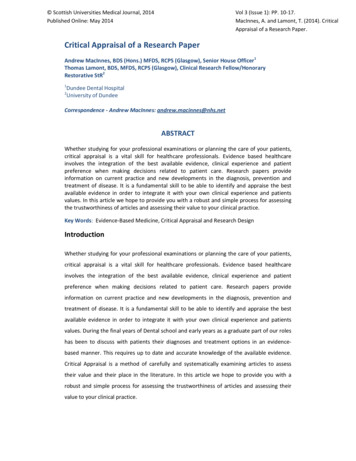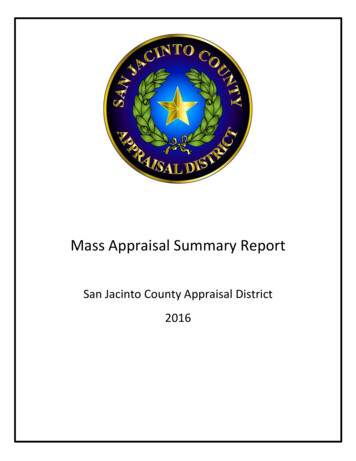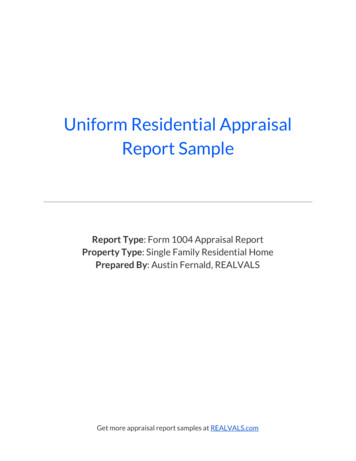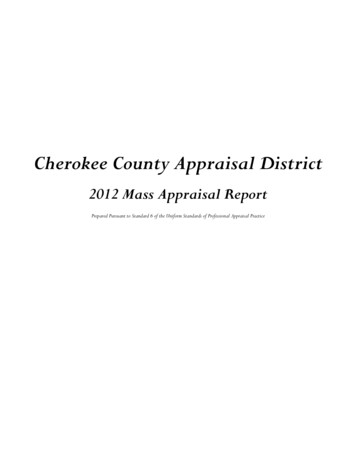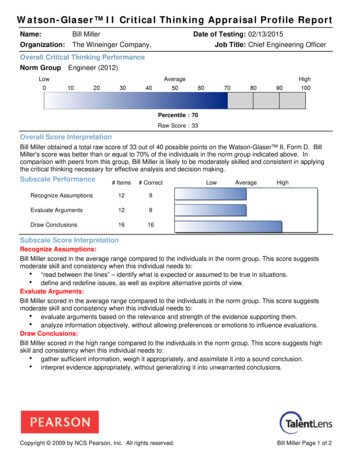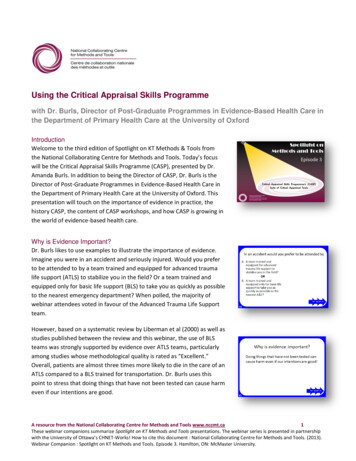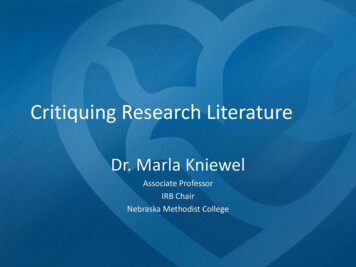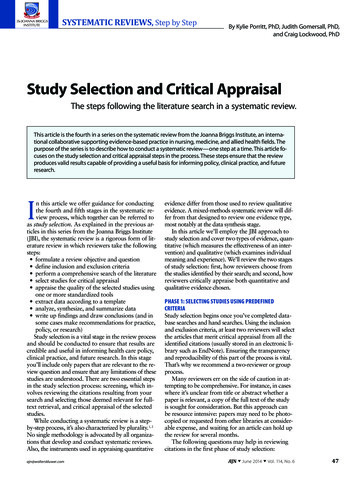
Transcription
SYSTEMATIC REVIEWS, Step by StepBy Kylie Porritt, PhD, Judith Gomersall, PhD,and Craig Lockwood, PhDStudy Selection and Critical AppraisalThe steps following the literature search in a systematic review.This article is the fourth in a series on the systematic review from the Joanna Briggs Institute, an international collaborative supporting evidence-based practice in nursing, medicine, and allied health fields. Thepurpose of the series is to describe how to conduct a systematic review—one step at a time. This article focuses on the study selection and critical appraisal steps in the process. These steps ensure that the reviewproduces valid results capable of providing a useful basis for informing policy, clinical practice, and futureresearch.In this article we offer guidance for conductingthe fourth and fifth stages in the systematic review process, which together can be referred toas study selection. As explained in the previous articles in this series from the Joanna Briggs Institute(JBI), the systematic review is a rigorous form of literature review in which reviewers take the followingsteps: formulate a review objective and question define inclusion and exclusion criteria perform a comprehensive search of the literature select studies for critical appraisal appraise the quality of the selected studies usingone or more standardized tools extract data according to a template analyze, synthesize, and summarize data write up findings and draw conclusions (and insome cases make recommendations for practice,policy, or research)Study selection is a vital stage in the review processand should be conducted to ensure that results arecredible and useful in informing health care policy,clinical practice, and future research. In this stageyou’ll include only papers that are relevant to the review question and ensure that any limitations of thesestudies are understood. There are two essential stepsin the study selection process: screening, which involves reviewing the citations resulting from yoursearch and selecting those deemed relevant for fulltext retrieval, and critical appraisal of the selectedstudies.While conducting a systematic review is a stepby-step process, it’s also characterized by plurality.1, 2No single methodology is advocated by all organizations that develop and conduct systematic reviews.Also, the instruments used in appraising quantitativeajn@wolterskluwer.comevidence differ from those used to review qualitativeevidence. A mixed-methods systematic review will differ from that designed to review one evidence type,most notably at the data synthesis stage.In this article we’ll employ the JBI approach tostudy selection and cover two types of evidence, quantitative (which measures the effectiveness of an intervention) and qualitative (which examines individualmeaning and experience). We’ll review the two stagesof study selection: first, how reviewers choose fromthe studies identified by their search; and second, howreviewers critically appraise both quantitative andqualitative evidence chosen.PHASE 1: SELECTING STUDIES USING PREDEFINEDCRITERIAStudy selection begins once you’ve completed database searches and hand searches. Using the inclusionand exclusion criteria, at least two reviewers will selectthe articles that merit critical appraisal from all theidentified citations (usually stored in an electronic library such as EndNote). Ensuring the transparencyand reproducibility of this part of the process is vital.That’s why we recommend a two-reviewer or groupprocess.Many reviewers err on the side of caution in attempting to be comprehensive. For instance, in caseswhere it’s unclear from title or abstract whether apaper is relevant, a copy of the full text of the studyis sought for consideration. But this approach canbe resource intensive: papers may need to be photocopied or requested from other libraries at considerable expense, and waiting for an article can hold upthe review for several months.The following questions may help in reviewingcitations in the first phase of study selection:AJN June 2014 Vol. 114, No. 647
SYSTEMATIC REVIEWS, Step by Step Is the article published in the time period coveredin the protocol? Is the article published in a language specified inthe inclusion criteria? Does the population studied meet the inclusioncriteria (such as adults or children or both)? Does the study look at the phenomena stated inthe review question? Has the study design been reported? Is it relevantto the review question? Is an outcome measured?If the review protocol specifies a date range for included papers, you would exclude a paper publishedoutside of that range (unless it is considered a primary or seminal source, in which case you could include a sentence in the review protocol stating thatpapers of this type may be included).Once you have chosen the studies that should becritically appraised, you’ll obtain and read the fulltext articles, discarding any that on second consideration do not meet the inclusion criteria.PHASE 2: APPRAISING SELECTED STUDIESThe purpose of critical appraisal is twofold. First,you’ll exclude studies that are of low quality (andwhose results may therefore compromise the validity of the recommendations of the review). And second, you’ll identify the strengths and limitationsof the included studies. The latter is important: aninterpretation of the studies’ results must be sensitiveto the characteristics of the studied populations, aswell as to how weaknesses in the study designs haveaffected those results.The optimal design for studies ofthe effects of interventionsinvolves true randomization.Typically, two reviewers use checklists to appraiseboth quantitative and qualitative evidence. If the reviewers disagree and cannot resolve their differencesthrough discussion, they consult a third reviewer. Anumber of checklists are available for assessing themany aspects of a study’s quality, including its design,its methods and analysis, and its clinical relevance.3The goals and methods of quantitative and qualitativeresearch differ, and so too do the checklists used to appraise them. The recently released 2014 version of theJBI’s reviewers’ manual offers checklists for appraisingboth types of studies (go to http://bit.ly/1h2F8RZ).448AJN June 2014 Vol. 114, No. 6Whether and how critical appraisal is conductedand reported is a significant indicator of quality insystematic reviews. At this stage, you’re assessing fulltext papers. For quantitative evidence you’re identifying the risk of bias in the published research in orderto decrease the possibility of including biased or misleading results. For qualitative evidence you’re emphasizing the rigor of the research and the level oftransferability. In the following two sections we’lllook more closely at these two types of appraisal.QUANTITATIVE STUDIES: APPRAISING EVIDENCE OFEFFECTIVENESSA range of study designs presents evidence on theeffectiveness of interventions (therapies, technologies, or devices, for example). These include experimental, quasi-experimental, observational, and casereports. The study design used depends on the review question investigated and has its own advantages and limitations.The ranking of evidence of effectiveness is generally linked to study design and the ability to maximize internal validity. For example, the randomizedcontrolled trial (RCT) is ranked higher than a cohortstudy or case–control study; a systematic review ofRCTs is ranked higher than a single RCT. Evidencehierarchies have been developed to be used as atool to assist reviewers in the ranking of evidence.One such tool is the JBI Levels of Evidence; a newversion was released in March (go to http://bit.ly/1qiic3Y).There has been a surge of international interest inusing GRADE (Grading of Recommendations Assessment, Development and Evaluation) when appraising RCTs for systematic reviews.5 As explainedby Goldet and Howick, GRADE differs from otherappraisal tools by separating the quality of the evidence from the strength of the recommendation, assessing the quality of the evidence for each outcome,and upgrading observational studies that meet certain criteria.5 (For more information, go to www.gradeworkinggroup.org.)Two notions of validity guide reviewers seeking toexamine the effectiveness of an intervention: internalvalidity and external validity. Internal validity refers tohow good the study is—that is, how well a causal relationship between intervention and outcome can beinferred from the findings. For example, an internallyvalid RCT implies that the differences observed between groups receiving different interventions (apartfrom random error) are due to the intervention underinvestigation.3 External validity, on the other hand, refers to the extent to which the results of the study canbe generalized to groups, populations, and contextsthat did not participate in the study. While it mayajnonline.com
appear that there’s a link between internal validity andgeneralizability, this is not the case. What a good studyallows for is greater confidence in the findings whenconsidering whether they are applicable to other populations. A good study does not automatically implygeneralizability, but a poor study at significant risk forbias is not as useful in informing policy or practice because of its flaws.many years. As an appraiser, you will need toassess how well attrition has been reported inthe studies.Establishing external validity involves readingin detail about the characteristics of the study population and how they were identified. It also encompasses identifying information about the study settingand whether it’s sufficiently similar to the context toInternal validity refers to how good the study is—that is, howwell a causal relationship between intervention and outcome canbe inferred from the findings.Establishing internal validity: assessing risk ofbias. The assessment of internal validity of quantitative studies involves determining whether the methods used in the study can be trusted to provide agenuine, accurate account of the intervention.6-9The four following sources of bias may affect internal validity and can be addressed by questions askedin the study-selection process. Selection bias refers to the researchers’ allocation of participants to groups that favor one ofthe treatments. This can be avoided by randomization and concealment of participant allocation, a form of blinding. Randomization ensuresthat every participant has an equal chance of being selected for any group. When appraising astudy, your goal is to determine how well randomization has been achieved in order to ascertain whether bias has influenced study results.Randomization may not be possible in all study designs; for example, case–control design is inherently prone to selection bias (also knownas allocation bias). Performance bias refers to the differences betweengroups in the care received. It can be avoided byblinding—the concealment of the treatment groupfrom both participant and investigator. Detection bias arises when outcomes are assesseddifferently for treatment and control groups. Blinding is a recognized means of alleviating this type ofbias; if researchers are unaware of which group aparticipant is assigned to, they will be more likelyto deal with that participant impartially. Detectionbias may also be referred to as measurement bias. Attrition bias refers to the differences in lossesof subjects between groups. Losses to follow-upshould be reported, though this is often difficultto do in longitudinal studies, which may lastajn@wolterskluwer.comwhich the findings will be applied. Note that externalvalidity is not about the accuracy or reliability of theresults of a study. Rather, it’s about the generalizability of the findings and the appropriateness of basing a change in practice on those findings.You’ll judge external validity by asking about thestudy’s sampling method and sample characteristics,its context (cultural or organizational factors), andthe intervention. How do these factors differ fromthose in the setting to which the findings will be applied? The optimal design for studies of the effectsof interventions involves true randomization. Truerandomization affects external validity by increasingTable 1. Critical Appraisal of Quantitative Evidence:A Checklist from JBI4 Is the assignment to treatment groups trulyrandom? Are participants blind to treatment allocation? Is allocation to treatment groups concealedfrom the allocator? Are the outcomes of people who withdrewdescribed and included in the analysis? Are those assessing the outcomes blind to thetreatment allocation? Are the control and treatment groups comparable at entry? Are groups treated identically other than forthe named interventions? Are outcomes measured in the same way for allgroups? Are outcomes measured in a reliable way? Is appropriate statistical analysis used?AJN June 2014 Vol. 114, No. 649
SYSTEMATIC REVIEWS, Step by Stepthe likelihood that participants in each group in thesample reflect the population they were recruitedfrom, hence affecting the ability to generalize beyondthe sample studied.Assessing characteristics of sample, culture, geography. Fortunately, most journals require studyauthors to include a table that shows age, sex, andother relevant clinical or demographic informationon participants. For example, a study of hemodialysis patients should include information on creatinineclearance levels, comorbidities, types of fistula, andother details that you can compare with your ownpatients to see how similar or dissimilar they are tothe study sample. Also, identifying characteristics ofthe setting will inform you as to whether the studyhas relevance to your own practice setting. Interesting results from a small community pharmacy willhave less relevance if you work in a large tertiarycare center with automated dispensing.and debated.10-13 In a quantitative review, studies areappraised to identify sources of bias (selection, performance, and attrition). But what constitutes quality in a qualitative study? Should it even beassessed? And if so, how? These are highly contentious questions, and there’s little consensus in thedebate, raising as it does issues of ontology, epistemology, and methodology.14Qualitative research is characterized by a wideranging methodological tradition, explained in partby ontological, epistemological, and philosophicalperspectives. Ontological assumptions—askingwhether something exists and how we can know itexists—influence why and how a qualitative researcherseeks knowledge about human consciousness. Approaches to qualitative research are informed byvarying ontological positions and are the source ofmuch debate, questioning, and contention amongqualitative researchers, since they deal with funda-External validity is not about the accuracy or reliabilityof the results of a study. Rather, it’s about the generalizabilityof the findings and the appropriateness of basing achange in practice on those findings.Cultural and geographic differences can have a major impact on external validity. Unique cultural practices or beliefs can exist between different groups,even between professions within the same hospital orwithin a profession across countries. Knowing thatcultural differences exist and are not limited to racialcharacteristics is an important step in establishing external validity. Geographic differences across countriescan be overt such as in prevalence studies of tropicalor contagious diseases, or they can be more subtlesuch as socioeconomic differences between states orboroughs. If you find a study from a country wherethere are different funding models for health care provision, consider the relevance of public versus privatefunding models and their potential impact on outcomes in your own context.Table 1 shows JBI’s checklist for appraising internal and external validity of RCTs and quasiRCTs.4QUALITATIVE STUDIES: APPRAISING EVIDENCE OFEXPERIENCESMethods for establishing credibility in systematicreviews using qualitative studies have been developed50AJN June 2014 Vol. 114, No. 6mentals of the meaning and the nature of knowledge. Constructivism, for example, is informed byan ontology that says how we know something isshaped through our interaction with it, while an interpretivist perspective is based on the notion thatmeaning is subjective, with an emphasis on individual meaning. Such differences—socially developedversus individual perspectives on how meaning ismade—reflect the diversity among qualitative researchers and in how they investigate knowledge.Those who believe that qualitative research shouldbe assessed for quality take that position because qualitative research can be flawed.13 Averis and Pearsonstate that the critical appraisal of qualitative researchcontributes to its ongoing credibility, transferability,and theoretical potential.11, 15 Some researchers have attempted to develop criteria for appraising qualitativestudies. In a review examining the layperson experience of diabetes and diabetes care, a modified versionof the Critical Appraisal Skills Programme (CASP)was used to assist with critically appraising eachpaper.16 The authors found the level of agreementbetween the assessors, when using the CASP, was reasonable.ajnonline.com
Hannes and colleagues compared three qualitativeappraisal instruments: the CASP checklist, the Evaluation Tool for Qualitative Studies (ETQS), and JBI’sQualitative Assessment and Review Instrument (JBIQARI) for Interpretive and Critical Research.10 Thestudy found that CASP was less sensitive to validitythan either the JBI-QARI or the ETQS, and whilethe ETQS had a clear instruction set, the JBI-QARI,with its congruity among philosophical perspective,methodology, and the methods used to conduct theresearch, was the most coherent of the three instruments.Some researchers resist the notion of critical appraisal for qualitative research, saying that relevantfindings or a “golden nugget” of information maybe missed if papers are excluded because of theirquality.17-20 Others argue that because qualitative research represents a unique form of science, its appraisal requires unique criteria. Walsh and Downewrite that the “epistemological status of most qualitative research makes the indiscriminate transferral”of criteria evaluating validity and reliability “inappropriate.”13Traditionally, the terms used to measure researchquality in quantitative research are reliability and validity. Reliability is the extent to which the results of astudy are repeatable in different circumstances; validity is the degree to which a study reflects or assessesthe concept the researcher is attempting to measure.Analogous terms relevant to qualitative research havebeen developed, and these are generally well acceptedby qualitative researchers.Dependability in qualitative research closely corresponds to the notion of reliability in quantitativeresearch.21 To maintain dependability, the qualitativeresearch process should be logical, traceable, andclearly documented.To maintain dependability, thequalitative research processshould be logical, traceable, andclearly documented.Credibility in qualitative research addresseswhether a finding has been represented correctly; itcorresponds to internal validity in quantitative studies. Credibility depends on the researcher’s ability toaddress the “fit” between respondents’ views andthe researcher’s representation of them; strategiesajn@wolterskluwer.comTable 2. Critical Appraisal of Qualitative Evidence:A Checklist from JBI4 There is congruity between the stated philosophical perspective and the research methodology. There is congruity between the researchmethodology and the research question orobjectives. There is congruity between the researchmethodology and the methods used to collect data. There is congruity between the researchmethodology and the representation andanalysis of data. There is congruence between the researchmethodology and the interpretation ofresults. There is a declaration of the researcher’s cultural or theoretical orientation. The influence of the researcher on theresearch, and vice versa, is addressed. There is representation of participants andtheir voices. There is ethical approval by an appropriatebody. There is a relationship between the conclusions of the study and the analysis or interpretation of the data.used to ensure credibility include member checks(returning to participants after data analysis), peerchecking (using outsiders to reanalyze data), prolonged engagement, persistent observation, and audit trails.Transferability in qualitative research refers tothe generalizability of results, an area of contentionamong researchers. It corresponds to external validity in quantitative research and might be thought ofas a matter of “fit” between the situation studiedand others to which one might be interested in applying the concepts and conclusions of that study;this is sometimes referred to as cross-case generalizations.22At JBI, we consider the critical appraisal of identified studies as a required stage in the process ofconducting a qualitative synthesis using meta- aggregation, though it is not necessary in some approaches to qualitative synthesis—meta-ethnography,for example. Meta-aggregation is a structuredAJN June 2014 Vol. 114, No. 651
SYSTEMATIC REVIEWS, Step by Stepa pproach in which findings of high-quality studiesare integrated; in meta-ethnography, the findings ofqualitative studies are reinterpreted so that new knowledge or theory can be generated. From the JBI perspective, critical thinking should be applied to studiesbefore they are included in a review and should focus on congruity between the following: epistemology and theoretical perspective—thatis, there is agreement between philosophy andthe set of assumptions theoretical perspective and methodology—that is,there is agreement between the set of assumptionsaligned with the particular perspective within theresearch and the theoretical underpinning of theresearch methodology and methods—that is, there isagreement between the theoretical underpinningof the research and the methods used within theresearchTable 2 presents points to consider when appraisingqualitative research from the JBI-QARI.4NEXT STEPSOnce you’ve critically appraised the studies found inthe literature search, your next steps are data extraction and analysis. How will you decide which studiesare of sufficient quality for the data extraction stageof the review? This is a question your entire reviewteam will take up, and no single approach is considered “best practice.” Wherever you draw the line forquality, though, you’ll have to apply a uniform standard for all studies considered. Only then will theconclusions and recommendations you draw in thereview be valid and useful. That will be the topic forthe next article in this series. Keywords: quality, quality assessment, systematic reviewKylie Porritt is a research fellow at the Joanna Briggs Institute inthe School of Translational Health Science, University of Adelaide,South Australia, where Judith Gomersall is a research fellow atthe National Health and Medical Research Council Centre forResearch Excellence in Aboriginal Chronic Disease KnowledgeTranslation and Exchange, and Craig Lockwood is an associateprofessor in Implementation Science. Contact author: Kylie Porritt, kylie.porritt@adelaide.edu.au. The authors have disclosed nopotential conflicts of interest, financial or otherwise.The Joanna Briggs Institute aims to inform health care decision making globally through the use of research evidence. Ithas developed innovative methods for appraising and synthesizing evidence; facilitating the transfer of evidence to healthsystems, health care professionals, and consumers; and creating tools to evaluate the impact of research on outcomes. Formore on the institute’s approach to weighing the evidence forpractice, go to http://joannabriggs.org/jbi-approach.html.52AJN June 2014 Vol. 114, No. 6REFERENCES1. Lockwood C, et al. Synthesizing quantitative evidence. Adelaide, SA: Lippincott Williams and Wilkins/Joanna Briggs Institute; 2011. Synthesis science in healthcare series.2. Pearson A, et al. Synthesizing qualitative evidence. Adelaide,SA: Lippincott Williams and Wilkins/Joanna Briggs Institute;2011. Synthesis science in healthcare series.3. Juni P, et al. Systematic reviews in health care: assessing thequality of controlled clinical trials. BMJ 2001;323(7303):42-6.4. Joanna Briggs Institute. Joanna Briggs Institute reviewers’ manual: 2014 edition. Adelaide, SA; 2014. rsManual-2014.pdf.5. Goldet G, Howick J. Understanding GRADE: an introduction. J Evid Based Med 2013;6(1):50-4.6. Joanna Briggs Institute. An introduction to systematic reviews. Changing practice: evidence-based practice information sheets for health professionals. 2001;5(Suppl 1):1-6.7. Khan KS, et al. Five steps to conducting a systematic review.J R Soc Med 2003;96(3):118-21.8. Pearson A, et al. The JBI model of evidence-based healthcare. Int J Evid Based Healthc 2005;3(8):207-15.9. Tricco AC, et al. The art and science of knowledge synthesis.J Clin Epidemiol 2011;64(1):11-20.10. Hannes K, et al. A comparative analysis of three online appraisal instruments’ ability to assess validity in qualitative research. Qual Health Res 2010;20(12):1736-43.11. Pearson A. Balancing the evidence: incorporating the synthesis of qualitative data into systematic reviews. JBI Reports2004;2:45-64.12. Sandelowski M. Rigor or rigor mortis: the problem of rigorin qualitative research revisited. ANS Adv Nurs Sci1993;16(2):1-8.13. Walsh D, Downe S. Appraising the quality of qualitative research. Midwifery 2006;22(2):108-19.14. Campbell R, et al. Evaluating meta-ethnography: systematicanalysis and synthesis of qualitative research. Health Technol Assess 2011;15(43):1-164.15. Averis A, Pearson A. Filling the gaps: identifying nursing research priorities through the analysis of completed systematic reviews. JBI Reports 2003;1(3):49-126.16. Campbell R, et al. Evaluating meta-ethnography: a synthesisof qualitative research on lay experiences of diabetes and diabetes care. Soc Sci Med 2003;56(4):671-84.17. Sandelowski M. “To be of use”: enhancing the utilityof qualitative research. Nurs Outlook 1997;45(3):125-32.18. Shaw RL, et al. Finding qualitative research: an evaluationof search strategies. BMC Med Res Methodol 2004;4:5.19. Sherwood G. Meta-synthesis: merging qualitative studies todevelop nursing knowledge. International Journal for Human Caring 1999;3(1):37-42.20. Walsh D, Downe S. Meta-synthesis method for qualitativeresearch: a literature review. J Adv Nurs 2005;50(2):204-11.21. Lincoln YS, Guba EG. Naturalistic inquiry. Newbury Park,CA: Sage Publications; 1985.22. Salmond SW. Steps in the systematic review process. In:Holly C, et al., eds. Comprehensive systematic review for advanced nursing practice. New York, NY: Springer Publishing; 2012.ajnonline.com
study, your goal is to determine how well ran-domization has been achieved in order to ascer-tain whether bias has influenced study results. Randomization may not be possible in all study designs; for example, case-control design is inherently prone to selection bias (also known as allocation bias).
